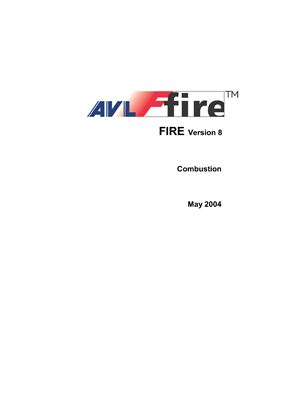AVL, 2004. 99 p.
Table of Contents
Introduction
Scope
Symbols
Configurations
Documentation
Overview
Spray/Combustion Interaction
Activation and Handling of the Combustion Module
Theoretical Background
Nomenclature
Roman Characters
Greek Characters
Subscripts
Superscripts
Combustion Module
Multi-Species Chemically Reacting Flows
Hydrocarbon Auto-Ignition Mechanism
An B Knock-Prediction Model
Empirical Knock Model
High Temperature Oxidation Scheme
Turbulence Controlled Combustion Model
Turbulent Flame Speed Closure Combustion Model
Coherent Flame Model
Standard CFM-2A Model
MCFM Model
ECFM Model
Probability Density Function Approach
PDF Transport Equation
Monte Carlo Simulation
Characteristic Timescale Model
Steady Combustion Model
NOx Formation Models
Zeldovich Model Formulation
Advanced NOx Model Formulation
Thermal NOx Mechanism
Prompt NOx Mechanism
Fuel NOx Mechanism
Soot Formation and Oxidation Model
Theoretical Background
The Soot Formation Process
The Mathematical Model
Advanced Soot Model
References
Related Publications
Combustion Input Data
Control
Ignition Models
Spark Ignition
Auto Ignition
Diesel
Diesel_MIL
HCCI
Knock
AnB Knock
Empirical Knock Model
Combustion Models
Eddy Breakup Model
Model Constants
Time Scale
Turbulent Flame Speed Closure Model
Model Constants
Coherent Flame Model
Time Scale
PDF Model
Rate Coefficient Treatment
Time Scale
Characteristic Timescale Model
Model Constants
Time Scale
Steady Combustion Model
Model Constants
User Defined Reaction Rate
Time Dependent Activation of Combustion
Combustion Models
Auto Ignition Models
Emission Models
NOx Models
Soot Model
2D Results
General Information
Auto Ignition Models
Emission Models
3D Results
General Information
CFM Models
Auto Ignition Models
Emission Models
Optional Output from Knock Models
Knock
An B Knock
Table of Contents
Introduction
Scope
Symbols
Configurations
Documentation
Overview
Spray/Combustion Interaction
Activation and Handling of the Combustion Module
Theoretical Background
Nomenclature
Roman Characters
Greek Characters
Subscripts
Superscripts
Combustion Module
Multi-Species Chemically Reacting Flows
Hydrocarbon Auto-Ignition Mechanism
An B Knock-Prediction Model
Empirical Knock Model
High Temperature Oxidation Scheme
Turbulence Controlled Combustion Model
Turbulent Flame Speed Closure Combustion Model
Coherent Flame Model
Standard CFM-2A Model
MCFM Model
ECFM Model
Probability Density Function Approach
PDF Transport Equation
Monte Carlo Simulation
Characteristic Timescale Model
Steady Combustion Model
NOx Formation Models
Zeldovich Model Formulation
Advanced NOx Model Formulation
Thermal NOx Mechanism
Prompt NOx Mechanism
Fuel NOx Mechanism
Soot Formation and Oxidation Model
Theoretical Background
The Soot Formation Process
The Mathematical Model
Advanced Soot Model
References
Related Publications
Combustion Input Data
Control
Ignition Models
Spark Ignition
Auto Ignition
Diesel
Diesel_MIL
HCCI
Knock
AnB Knock
Empirical Knock Model
Combustion Models
Eddy Breakup Model
Model Constants
Time Scale
Turbulent Flame Speed Closure Model
Model Constants
Coherent Flame Model
Time Scale
PDF Model
Rate Coefficient Treatment
Time Scale
Characteristic Timescale Model
Model Constants
Time Scale
Steady Combustion Model
Model Constants
User Defined Reaction Rate
Time Dependent Activation of Combustion
Combustion Models
Auto Ignition Models
Emission Models
NOx Models
Soot Model
2D Results
General Information
Auto Ignition Models
Emission Models
3D Results
General Information
CFM Models
Auto Ignition Models
Emission Models
Optional Output from Knock Models
Knock
An B Knock

